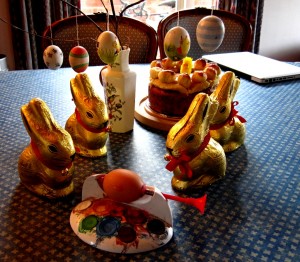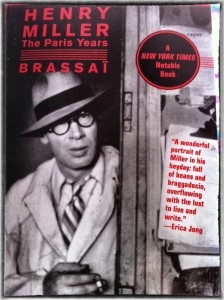The breakfast table this morning.
Snooping and state power
This morning’s Observer column:
The basic scenario hasn’t changed. Because of technological changes, we are told, criminals and terrorists are using internet technologies on an increasing scale. Some of these technologies (eg Skype) make it difficult for the authorities to monitor these evil communications. So we need sweeping new powers to enable the government to defend us against these baddies. These powers are as yet unspecified but will probably include “deep packet inspection” as a minimum. And, yes, these new measures will be costly and intrusive, but there will be “safeguards”.
The fierce public reaction to these proposals seems to have taken the government by surprise, which suggests ministers have been asleep at the wheel. My hunch is that the proposals were an attempt by the security services to slip one over politicians by selling them to senior officials in the Home Office, who, like their counterparts across the civil service, know sweet FA about technology and are liable to believe 10 implausible assertions before breakfast. In that sense, the Home Office has been “captured” by GCHQ and MI5 much as the health department has been captured by consultancy companies flogging ludicrous ICT projects….
Kindling
Brassai on Henry Miller
The Hungarian photographer, Brassai (whose real name was Gyula Halász), is one of my favourite artists (and a huge print of one of his most celebrated photographs — Les Escaliers de Montmartre — hangs in our dining room). But I had no idea he could write — until I stumbled on his book, Henry Miller: The Paris Years. It’s a startlingly illuminating and well-written book about a writer who was one of the photographer’s closest friends in Paris in the inter-war years, and who — until now — has always been an enigma to me.
Here’s how it opens:
“How does your memory of this compare with yours? I seem to see you standing in the Gutter at the Dome, a l’angle de la rue Delambre et Blvd Montparnasse… You had a newspaper in your hand. You told us you have begun to practice photography. It may have been the year 1931. The spot where you stood I see so vividly that I could draw a circle around it.” In a letter to me, this is how Henry Miller recalled our first meeting. “It’s strange”, he told me, “but with most people we remember neither where nor under shat circumstances we met. But I remember the first time you and I met as if it were yesterday.”
My memory doesn’t quite compare with his. My memory of the first time Henry and I met was that it took place in December 1930, shortly after he had arrived in France. My friend the painter Louis Tihanyi introduced us. Louis was sort of the Dome’s PR man — everyone recognised his olive green corduroy overcoat, worn to a shine, his wide-brimmed gray felt hat, his monocle, his fleshy lower lip. He was the spitting image of Alphonse XIII — minus the pencil mustache. Every night, table by table, Louis worked the crowded Dome terrace, which, beneath the luminous green shade of the trees on the boulevard, was always festive, as if every day were Bastille. Although deaf, and very nearly dumb as well, Louis was the best-informed man in Montparnasse. He knew not only every single one of the regulars, but the measure and worth of each newcomer.
“I want you to meet Henry Miller, an American writer,” he announced in his abrupt, guttural voice, which somehow always managed to make itself heard over the hum of conversation and the noise from the street”.
And there was Henry Miller. I will never forget the first sight of his rosy face emerging from a rumpled raincoat: the pouting, full lower lip, eyes the color of the sea. His eyes were like those of a sailor skilled at scanning the horizons through the spray. They always conveyed calmness and serenity, those eyes, and even though their expression seemed as guileless and attentive as a dog’s, they lay in ambush behind large tortoiseshell glasses…”.
I couldn’t put it down. It’s a fascinating blend of insight, affection, forgiveness and acuity. And, like Hemingway’s A Moveable Feast and Woody Allen’s Midnight in Paris
, it’s beautifully evocative of an astonishing period in the life of my favourite city.
I want to be alone: Colm Toibín on solo living
From the Guardian.
On Saturday I wake at six and relishing the day ahead. I teach on Mondays and Tuesdays; I have to reread a novel for each class and take notes on it. Nothing makes me happier than the thought of this. I often lie there until the seven o’clock news comes on, grinning at the thought of the day ahead.
All day I will read and take notes. The worst-case scenario is that I might need another book, and this involves lot of decision-making and self-consultation. It might end in a five-minute walk to the university library. But normally I go nowhere except to the fridge if I am hungry to see what’s there, or to the sofa to lie down if my back is tired, or to the rocking chair if I feel a need to rock.
Normally there’s not much in the fridge. In the kitchen there is an oven I have never opened. And there are pots and pans whose purpose may be decorative for all I know. But I know where all my notebooks are. They are all over the apartment. That is the best part. I can leave them where I like and no one touches them or wants to put them away anywhere. No one sighs about books and notebooks piled up. All of the notebooks have stories half-written in them, or stray sentences in search of a home, or musings that are none of anyone’s business. If I like, I can go to one of them and add some paragraphs. I don’t have to excuse myself, explain myself, or put on a distracted writer’s look in order to get down to work. Or worry that someone has, in my absence, opened one of my notebooks and found that they don’t like the tone of what is written there.
May 31: the make-or-break date for the Eurozone
The first national referendum on the proposed European Fiscal Treaty takes place in Ireland on May 31. My hunch is that it will be rejected. Elain Byrne had an interesting article in the Guardian about the background.
Ireland has rejected two of the four European referendums put to voters over the course of the last decade. The Fine Gael-Labour coalition, now a year in office, has already lost a referendum – the public rejected a political reform poll last October. A hint of government complacency and a public overwhelmed by personal debt, rising unemployment and budget cuts could scupper the yes vote’s chances.
The Irish Central Bank published a study on Thursday which showed that Irish households have suffered the most severe wealth destruction in Europe. Dan O’Brien in the Irish Times reported on Friday that the net worth of Irish households has fallen by 35% since 2007, the 17th consecutive quarter of decline. And yet Ireland does not do protest. Greek-style demonstrations do not suit an Irish mindset weary of decades of Northern Ireland violence. We are essentially a very conservative people. Nonetheless, there is a steady upswell of dissent building among the middle classes.
It is articulated through something very close to the Irish psychic–land. As part of the European Central Bank, European Commission and IMF programme, the government is obliged to introduce a household charge. This is an attempt to broaden the tax base as one means of addressing the yawning €18bn gap between income and expenditure. Ireland is virtually unique among its European neighbours in not having any property-based charges.
The deadline for the €100 charge was last Friday. To date just 886,000 householders had voluntarily registered of the 1,570,814 properties affected…
People in Ireland are very pissed off. They’ve had their love affair with Europe, and it’s over, just like their love affair with Fianna Fail and the political establishment it spawned is over.
Later: When asked in a Guardian interview whether the Euro was a disaster, Stephanie Flanders, the BBC’s Economics Editor replied:
“It’s more than a disaster, I think it’s a tragedy. It was quite an ambitious project, which had pros and cons, but it was basically mis-sold to everybody. So the Germans were sold it as a way of spreading a German approach to economics, and German stability, across the eurozone; but they were told that it would come without any obligations on them, there would be no bailouts. At the same time, the others were told this was a quick ticket to German stability, and they would get low interest rates and low inflation, and they weren’t told: there’s one catch – you have to be as competitive as Germany for ever. And if you do have any problems, all the usual tools you’d use to get out of them won’t be available to you. For many of these countries, the implication is years more austerity, which has a big sign on it saying, ‘Brought to you by the euro.'”
Spot on.
Turf wars and user-generated content
The New York Times has a feature by Elissa Gootman about American parents who encourage their children’s writing by self-publishing their books. She quotes a dismissive comment by Tom Robbins, a novelist of whom I had never heard but who, according to this profile, writes 500 words a day longhand:
“What’s next?” asked the novelist Tom Robbins. “Kiddie architects, juvenile dentists, 11-year-old rocket scientists? Any parent who thinks that the crafting of engrossing, meaningful, publishable fiction requires less talent and experience than designing a house, extracting a wisdom tooth, or supervising a lunar probe is, frankly, delusional.”
Writing in the Guardian, Dan Gillmor is (rightly) having none of this:
Robbins’ annoyance was a classic of the genre and clever in its framing, but not terribly original as an idea. For years we’ve been treated to curmudgeon-isms from a variety of professionals who betray fear and/or contempt when the hoi polloi finds a way across the moats and into their castles. In a field to which I pay close attention – what has become known in the past decade as citizen journalism – angst from employed journalists has never fully abated. A few media organisations, including this newspaper, have embraced the long-obvious reality that the former audience can and should be integral to the journalism process. Some others have concluded that they can get their audiences to do some of the work for no compensation beyond a pat on the head; this is shabby but, sadly, in wide practice. And many others still fear, or even loathe, the very idea that the hallowed newsroom pros’ authority has been challenged at all.
The term “citizen journalism” has led to all kinds of clever analogies, on which Robbins builds in his Times quote. One of my favourites is “citizen surgeon”, which I first heard many years ago. Of course, I don’t want anyone but a certified surgeon cutting into me if required. But humans have done all manner of “citizen medicine” through the aeons. When my mother sterilised a pin in a flame and poked around my finger to remove a splinter many decades ago, she was not performing surgery, but it was medical care.
In today’s world of democratised technology, average people are playing roles they never dreamed of in the past. That is why we have legions of citizen astronomers, among armies of citizen scientists in a variety of disciplines, making discoveries every week. The need for well-trained scientists has not diminished, but the rest of us are contributing in new and immensely valuable ways.
Spot on.
Painting with light
The rise of e-reading
Fascinating Pew report on the e-reading phenomenon.
Main findings:
A fifth of American adults have read an e-book in the past year and the number of e-book readers grew after a major increase in ownership of e-book reading devices and tablet computers during the holiday gift-giving season.
The average reader of e-books says she has read 24 books (the mean number) in the past 12 months, compared with an average of 15 books by a non-e-book consumer.
Those who read e-books report they have read more books in all formats. They reported an average of 24 books in the previous 12 months and had a median of 13 books. Those who do not read e-books say they averaged 15 books in the previous year and the median was 6 books.
For device owners, those who own e-book readers also stand out. They say they have read an average of 24 books in the previous year (vs. 16 books by those who do not own that device). They report having read a median of 12 books (vs. 7 books by those who do not own the device).
Overall, those who reported reading the most books in the past year include: women compared with men; whites compared with minorities; well-educated Americans compared with less-educated Americans; and those age 65 and older compared with younger age groups.
30% of those who read e-content say they now spend more time reading, and owners of tablets and e-book readers particularly stand out as reading more now. Some 41% of tablet owners and 35% of e-reading device owners said they are reading more since the advent of e-content. Fully 42% of readers of e-books said they are reading more now that long-form reading material is available in digital format. The longer people have owned an e-book reader or tablet, the more likely they are to say they are reading more: 41% of those who have owned either device for more than a year say they are reading more vs. 35% of those who have owned either device for less than six months who say they are reading more.
Men who own e-reading devices and e-content consumers under age 50 are particularly likely to say they are reading more.
The prevalence of e-book reading is markedly growing, but printed books still dominate the world of book readers. In Pew’s December 2011 survey, they found that 72% of American adults had read a printed book and 11% listened to an audiobook in the previous year, compared with the 17% of adults who had read an e-book.
This is really interesting stuff which, among other things, tends to undermine the widespread meme about the ‘death’ of the book. It’s the old misconception: confusing function with format.
Full report here.
The US Masters remixed
There are only two golf competitions that persuade yours truly to book the family TV for the evening. One of them starts tonight. But I’ve never seen it like this before.




